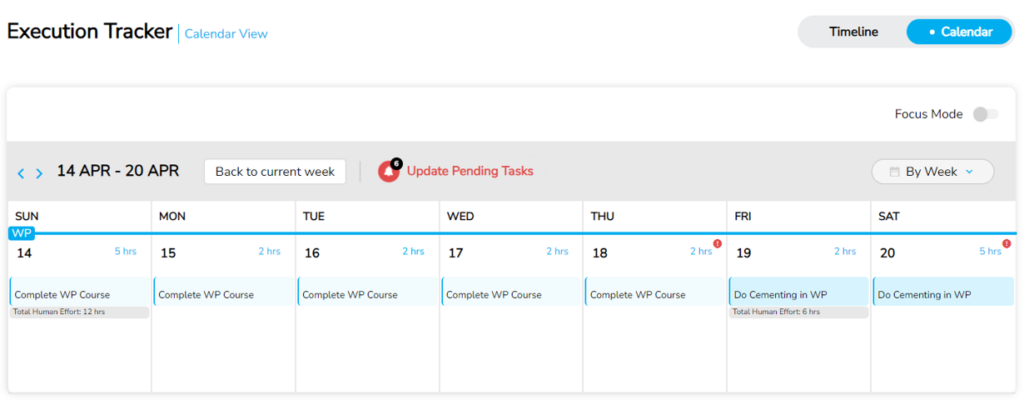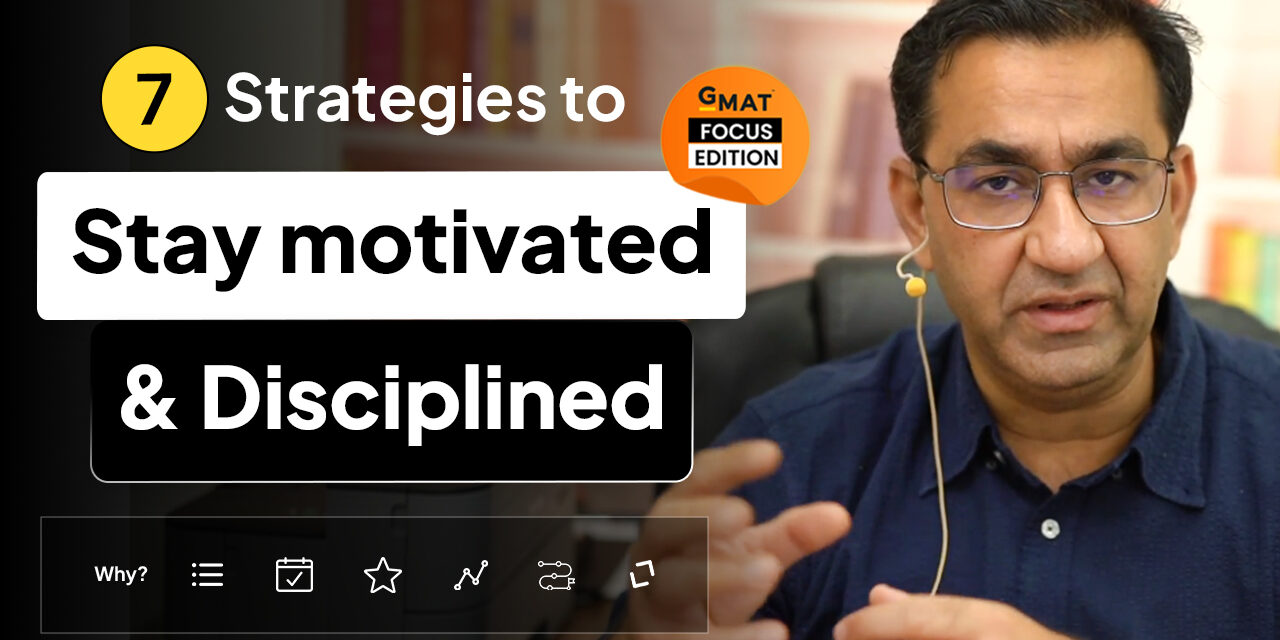Introduction:
How does one cultivate the mindset necessary to reach their target score in the first attempt? What GMAT strategies ensure that this extended journey of preparation is not just endured but mastered? And perhaps most crucially, how does one foster the discipline required to maintain unwavering focus through the ups and downs of this challenging period?
The journey to conquer the GMAT, especially its Focus Edition, is more than a test of intellectual capability; it is a marathon that challenges your discipline, strategic planning, and mental fortitude. At e-GMAT, we understand that achieving a high score on your first attempt is not merely a testament to your intelligence but also to your perseverance, strategic preparation, and the discipline to remain focused. Hence, we present a comprehensive, seven-strategy guide designed to keep you Motivated and Disciplined and to transform your preparation into a journey of self-discovery and significant personal growth.
Here’s a sneak peek at the Seven GMAT Strategies for Motivation and Discipline:
Strategy 1: Understand the “Why” behind your GFE attempt.
Transform your GMAT journey with a compelling “Why” that fuels your drive and defines your path to success.
Strategy 2: Create a plan to get to your target score.
Map your success with a precision-targeted plan, breaking the GMAT challenge into conquerable milestones.
Strategy 3: Comprehend the reasoning behind every step of the plan.
Maximize your study effectiveness by knowing the ‘why’ behind each step, turning strategy into achievement.
Strategy 4: Understand the metrics you need to achieve
Set and hit precise performance metrics, turning abstract goals into tangible, measurable successes.
Strategy 5: Understand that Learnings and outcomes are non-linear.
Leverage the power of non-linearity, where unexpected leaps forward redefine the pace of your progress.
Strategy 6: Create your study schedule based on your plan and your routine.
Transform your daily routine into a ladder to GMAT success, where every study session is a step closer to your dream score.
Strategy 7: Communicate your study commitments to your friends and family.
Strengthen your GMAT journey with the support of loved ones, making your preparation a shared venture towards success.
Outline:
- Strategy 1: Understand the “Why” behind your GFE attempt.
- Strategy 2: You need to create a plan to get to your target score.
- Strategy 3: Understand the reasoning behind every step of the plan.
- Strategy 4: Understand the metrics you have to achieve for each step.
- Strategy 5: Learnings and outcomes are non-linear.
- Strategy 6: Create your study schedule based on your plan and your routine.
- Strategy 7: Communicate your study commitments to your friends and family.
Now let’s dive in…
Strategy 1: Understand the “Why” behind your GFE attempt.
Embarking on GMAT Focus Edition preparation requires not just intellectual effort but a deep understanding of your “why.” This foundational step is crucial as it transforms preparation from a daunting task into a meaningful journey of self-discovery. A compelling “why” goes beyond the superficial desire to pursue an MBA, targeting a vision of impactful change. For example, there’s a significant difference between a general wish like “I want to do an MBA” and a specific ambition such as “I want to lead the transformation in IT Consulting.” The latter not only clarifies your goal but also highlights the intended impact, proving that specificity in your “why” is essential for inspiring perseverance and motivation.
Understanding your “why” is about setting a clear, transformative goal that fuels your drive and outlines your path. It’s about shifting from vague aspirations, like wanting to switch to IT Consulting, to precise visions, such as aiming to emulate a role model making global changes in a specific domain. This clarity in purpose ensures that every aspect of your preparation is driven by a strong, personal motivation.
Here are some good Whys’:
Innovate in Healthcare: “I aim to revolutionize patient care through digital health innovations, making healthcare accessible to underprivileged communities worldwide.
Bridge Education Gaps: “I want to develop and lead initiatives that bridge the educational divide in remote areas through technology, inspired by my own upbringing in a rural setting lacking educational resources.”
Leadership in Technology: “My objective is to evolve from a tech contributor to leading teams execute multimillion-dollar artificial intelligence projects that enable useful experiences for hundreds of millions of users.”
Not only that, it also helps with the next phase of applying to your dream B-Schools! Click here to watch how knowing his “Why” helped Abhik convert his all-important Booth School of Business interview and secure a final admit.
Strategy 2: Create a Plan to Reach Your Target Score
Creating a personalized study plan is essential for GMAT success, acting as a navigational compass through your preparation journey. This plan requires understanding your current standing, target score, and the timeframe available, focusing on closing the “Ability Gap” between your present capabilities and desired outcomes for each GMAT section. Identifying this gap is crucial, as it directs your study efforts more efficiently, ensuring that your preparation is both focused and strategic.

Transforming your overarching goal into smaller, achievable 10 to 15-day milestones makes the journey manageable and keeps motivation high. Each milestone represents progress towards your target score, providing a sense of achievement and a clear indication that your goals are within reach. These milestones not only mark your advancement but also fuel your journey, offering emotional boosts and maintaining discipline. They crystallize the path to your goal, turning broad aspirations into a structured, actionable plan.
This approach ensures your GMAT preparation is guided with precision, bringing you ever closer to your target score through a series of calculated, achievable steps.
Strategy 3: Understand the Reasoning Behind Every Step of the Plan
Understanding the ‘why’ behind each step of your GMAT preparation plan transforms your study from routine to strategic mastery. It’s crucial to know the purpose behind each phase of your study plan, as each is designed with a specific outcome in mind—for instance, starting with foundational concepts before advancing ensures a solid base, while subsequent stages aim to deepen understanding and application skills.
Similarly, test readiness exercises, simulating exam conditions, are structured to build your testing stamina and adaptability, enhancing your time management and stress handling capabilities.
Clarification on any unclear steps is vital, as moving forward without comprehension is counterproductive. This strategy emphasizes the alignment of intention and action, making every study session count towards closing the “Ability Gap” and achieving your target score. By understanding the reasoning behind your prep plan, you’re empowered to navigate your GMAT journey with confidence, ensuring each step is purposefully directed towards success.
Strategy 4: Understand the Metrics You Have to Achieve for Each Step
To achieve a high GMAT score, you must set clear, specific metrics for each preparation step, which distinguishes successful candidates. You need to understand the exact goals, such as to score V85, you need to reach 90th percentile in Critical and to do that, you need to 70% accuracy in Hard CR questions. This precision is critical. It guides your study habits and techniques, bridging the gap between your current capabilities and desired outcomes. I frequently notice a discrepancy between students’ goals and their actual outcomes. It’s common for those targeting the 99th percentile to overlook a module, believing it to be less crucial. This approach might suffice for someone aiming for the 70th percentile, but for a 99th percentile aspirant, where the margin for error is incredibly slim, such decisions can be detrimental.

Similarly, to attain mastery it is important to incorporate strategic breaks, allowing for mental rest and improved material absorption upon return. Effective breaks, planned after completing significant modules or practice sets, ensure sustained engagement and productivity throughout the study journey.
Strategy 5: Embrace the Non-Linearity of Learning and Outcomes
Improvement on the GMAT doesn’t follow a linear pattern. Aiming to hit the 99th in Reading Comprehension percentile with 50 hours of effort, you can’t expect that putting in 40 hours will get you to the 80th percentile. Rather, you may just be at 70th percentile.
Students who do not understand this non-linearity take tests after 35 hours of investment and get discouraged by the results. Some start of enthusiastically but tail off towards the end, failing to reach their target improvement.
This non-linear progression should be seen as motivational rather than discouraging. Rajat Sadana draws a parallel to the exponential returns of an MBA – going from earning $25,000 a year to $20,000 or $25,000 a month within 2 years, highlighting how substantial effort can lead to transformative results, far exceeding initial investments.
Embracing this aspect of GMAT preparation encourages persistence through the ups and downs, viewing each challenge not as a setback but as an opportunity for substantial growth and achievement, setting the foundation for the right expectations and for both personal and academic development.
Strategy 6: Integrate Your Study Schedule into Your Daily Routine
You need to weave your GMAT study plan into your daily life to maximize its effectiveness. Commit to specific study times as if they were important work meetings, ensuring your preparation gets the attention it deserves. This method requires discipline; treat your study time as non-negotiable and protect it from other commitments. Following this structured schedule not only builds a steady routine but also enhances your mental toughness, preparing you for the test day and beyond.

Equally crucial is reflecting on and tweaking your study schedule. By regularly checking how well you stick to your plan and analyzing your performance, you can pinpoint and fix any inefficiencies. If you discover that certain times are less productive or that other responsibilities are cutting into your study hours, acknowledging these issues allows you to adjust your schedule accordingly. This ongoing cycle of evaluation and modification ensures your GMAT preparation remains an integral part of your daily routine, helping you stay on course to hit your target score.

Strategy 7: Communicate your study commitments to your friends and family.
Sharing your “why” with friends and family transforms GMAT preparation from a solitary endeavor into a shared journey. It’s not just about informing them of your goals but integrating them into your mission, fostering a deeper understanding and respect for your dedication. This communication ensures that your support network recognizes the importance of your efforts and the underlying motivations, strengthening your bonds and securing their support throughout your journey.
Moreover, clear communication of your study commitments incorporated into your daily routine, as discussed in Strategy 6, reinforces their integration into your daily life, preventing conflicts and misunderstandings. It highlights the importance of having a supportive environment that respects your study schedule, contributing to your success by providing encouragement, ensuring quiet study times, and celebrating your achievements, thus enhancing the overall GMAT preparation experience.
Conclusion:
Mastering the GMAT requires more than just hard work and intelligence; it demands a holistic approach that encompasses strategic planning, a deep understanding of your motivations, disciplined preparation, and the support of your personal network. By internalizing and applying these seven GMAT strategies, you embark on a transformative journey that extends beyond the exam to your broader academic and professional aspirations.
Let the clarity of your “why” illuminate your path, let your meticulously crafted plan guide your steps, and let the support of your loved ones sustain you through this journey.
“Success is not the key to happiness. Happiness is the key to success. If you love what you are doing, you will be successful.” Albert Schweitzer















